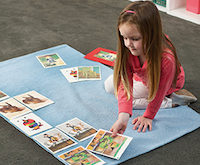 The sensorial curriculum is one of the brilliant foundations of Montessori education. The materials that Dr. Montessori created are elegant in isolating each of the senses, and the Bells are among the most beautiful and fascinating of the sensorial materials.
The sensorial curriculum is one of the brilliant foundations of Montessori education. The materials that Dr. Montessori created are elegant in isolating each of the senses, and the Bells are among the most beautiful and fascinating of the sensorial materials.
Even if you have no experience with the Bells, or they were not included in your training, you can teach yourself. You already know how to give lessons. If you can present the Sound Cylinders, you can learn to give the lessons for the Bells. And if there are no Bells in your school, there are ways to begin, and invest slowly, as we discuss below.
Sequence of the Lessons
Young children are fascinated with the exploration of musical sound. The sensitive period for music is the same as that for language, so it’s important to introduce the Bells in the primary years. The lessons follow the same sequence as the other sensorial materials: recognition of contrast, matching pairs, and grading a series. In addition, the Bells require specific lessons in care, handling, and playing.
- Caring for the Bells: Clean with a feather duster or soft cloth. Never use polish which can change the metal and alter the tone.
- Carrying a bell: Hold by the stem, with the other hand underneath the base.
- Striking a bell: A rubber mallet makes a softer, more beautiful tone than a wooden one. Hold the end of the mallet with the thumb and first two fingers, swinging it softly and freely.
- Dampening the sound: Use the felt end of the damper to stop the sound.
- Playing the scale: Play up the brown and down the white bells to check that the Bells are in the correct order and to familiarize the ear with the diatonic scale.
- Matching: Start by matching the pitches of three contrasting randomly-placed brown bells to the corresponding white bells.
- Identifying and naming pitches: High, higher, highest, or low, lower, lowest.
- Grading: Mix the brown bells and grade them from low to high. Find the first two bells by matching, then grade the remaining bells by listening for the next highest bell.
- Naming each bell by its note: c, d, e, f, g, a, b, c.
Demystifying the Bells is an excellent, detailed DVD that demonstrates every lesson. In under an hour, you can learn more than enough to get started. For extensions, games, and advanced lessons, watch the DVD again at a later date.
Bringing the Bells to your Classroom
“In addition to providing a sensorial means for children to increase the acuity of their auditory perceptions, the bells are a beautiful musical instrument in their own right.”
—Jean Miller, Montessori Music
Yes, the Bells* are an expensive investment but well worth the cost. Educate parents during back-to-school night about the importance of the Bells, and inspire them to have a fundraiser to buy the complete set. You could share a set with other classrooms, taking turns having them in your room.
You can present most of the lessons with just the eight white and their matching brown bells. I once found a box of dusty, damaged bells in my school’s storage and was able to clean and repair the white and brown bells with inexpensive replacement felt gaskets and wooden tops from Nienhuis. Later, you can add the black bells (the sharps and flats) and the materials for notation. Every year your wish list could include a pair of bells: “Need F sharp!” A handy parent could make a bell cabinet or table long enough for all of the Bells. The musical staff can be drawn on a white board and discs with note names are simple to make.
Fascination with the Bells
I have witnessed an entire classroom become more peaceful as one child spontaneously played a bell, waiting until the beautiful tone faded away completely. Children who aren’t yet interested in the Bells absorb auditory training from hearing others match and grade the Bells or play and compose music. To signal transition times, play the white bells up and then down, singing “do, re, mi…” and the children will join in, learning the C major scale.
 |
| Hu-mu-hu-mu-nu-ku-nu-ku |
Elementary children love composing and playing music with the Bells, especially if the Tone Bars aren’t available. Older children who have no experience with the Bells often find the grading lessons fascinating. Children (ages 5+) love to express and integrate what they’re learning through musical composition. One of my students was intently researching Hawaii when he suddenly went over to the Bells and composed a lovely melody, playing a different bell for each syllable of the incredibly long name of his favorite fish: Hu-mu hu-mu nu-ku nu-ku a-pu-a-a!
Many schools have weekly music classes where children learn songs and play instruments. These programs are an excellent supplement, and yet I hope that this article has struck a chord. There really is no substitute for having the Montessori Bells as an integral part of the prepared environment, so children can explore, create, and play music whenever they choose. Introducing these fascinating lessons in auditory training to children at just the right age is a gift that will enrich their lives forever.
 Montessori blog Montessori blog
Montessori blog Montessori blog 
